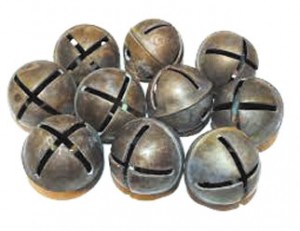Since early Roman times bells have adorned many a horse, not only adding to the beauty of the steed, but to a more practical purpose — warning pedestrians to step aside. Horse bells have been believed to bring good luck, protect against disease, ward off evil and were often used to flaunt the affluence and status of the owner.
From the beautifully crafted bells inscribed for presentation to royalty and statesmen, to strands of common bells used to clear the way for packs of work horses, these wonderful bells of years past have captured the interest of today’s collectors..
In the mid-1800s it became fashionable, among the affluent, to dress in fine clothes and furs and go sleigh riding. Beautifully crafted sleighs pulled by well-groomed horses adorned with bells became a common sight during the winter months, especially in the New England states where people often referred to them as “sleigh bells.” This term quickly filtered into our culture through songs, stories and poetry. One of the most popular examples is the 1857 tune “One Horse Open Sleigh,” more commonly known as “Jingle Bells.”
In 1810 William Barton opened the first U.S. sleigh bell company in East Hampton, Connecticut. By the middle of the century so many sleigh bell factories had opened in the area that East Hampton became known worldwide as “Belltown.”
Barton’s leading competitor, the N. N. Hill Company, changed the face of the industry when they developed a process of stamping sleigh bells out of sheet metal. While an average day of casting bells produced about 500 bells, the new production method of stamping could turn our in excess of 25,000 in a 24 hour period. In 1839, the total number of bells manufactured in East Hampton was reportedly 14,000. By 1850 that number had jumped to over three million bells.
With the advent of the Model T, horses as a form of transportation became a thing of the past. By the end of the 1940s the majority of the factories that had once produced millions of bells per year had closed. Today the only remaining factory in “Belltown” is Bevin Brothers of East Hampton.
Collectible sleigh bells of sterling, bronze, and gold and silver plate in traditional forms, as well as novelty bells in the shape of animals, are popular with collectors and can be found online and at most major antique malls. But beware, reproduction abounds!
Petal, Raspberry and Acorn are the most commonly reproduced designs. Watch for splotchy discoloration of green, brown or black. This is an attempt to make the bells appear to have age-appropriate oxidation, when it fact they have been painted with these colors.
Actual antique bells, if they are unpolished, will have discoloration, but it will be spread evenly over the surface of the bell. You should also see a layer of dirt and harness oil from years of use. Polished antique bells will have a brownish gold or rosy gold color and their surface will have a texture from the sand molds in which they were produced.
Someone on your Christmas list hard to buy for? A beautiful strand of sleigh bells make a wonderful gift. I know. That’s how I got mine! Until next time . . . Linda
Linda Kennett is a professional liquidation consultant specializing in down-sizing for seniors and the liquidation of estates and may be reached at lkennett@indy.rr.com or 317-258-7835.



